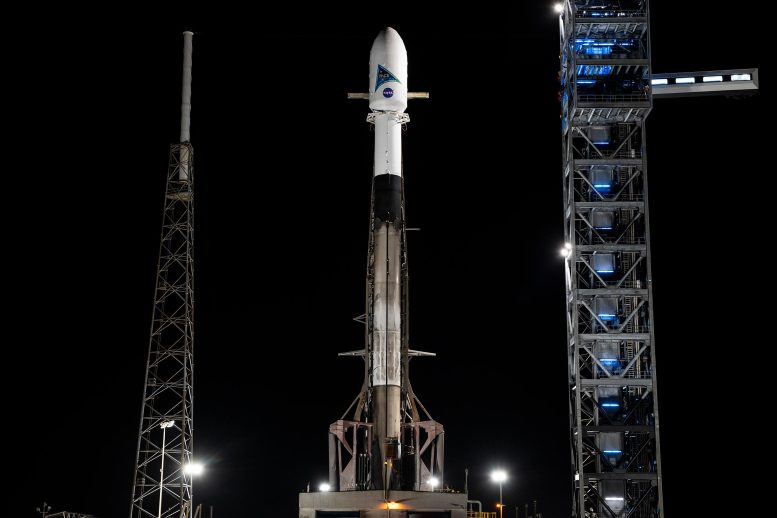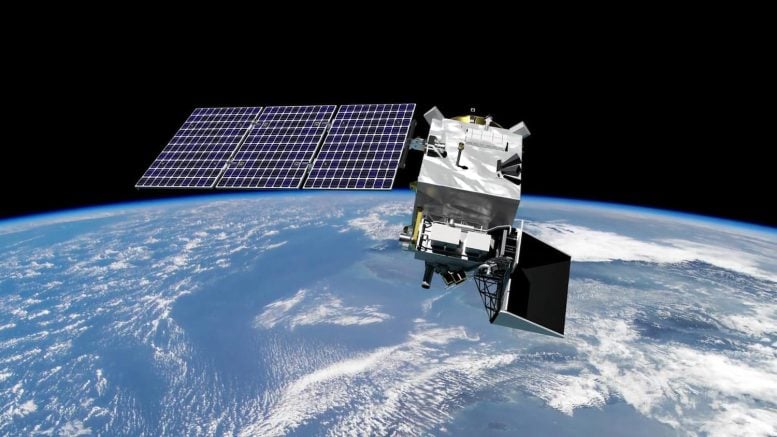
A SpaceX Falcon 9 rocket with NASA’s PACE (Plankton, Aerosol, Cloud, ocean Ecosystem) spacecraft encapsulated atop is raised to a vertical position at Space Launch Complex 40 at Cape Canaveral Space Force Station in Florida on Monday, February 5, 2024. PACE is NASA’s newest earth-observing satellite that will help increase our understanding of Earth’s oceans, atmosphere, and climate by delivering hyperspectral observations of microscopic marine organisms called phytoplankton as well as new data on clouds and aerosols. Credit: SpaceX
NASA and SpaceX have delayed the PACE mission launch to 1:33 a.m. EST on February 7 due to unfavorable weather, with the spacecraft and rocket remaining healthy. Live coverage will be available on NASA+ and NASA TV.
NASA and SpaceX are standing down from the Tuesday, February 6 launch of the agency’s Plankton, Aerosol, Cloud, ocean Ecosystem (PACE) mission due to unfavorable weather conditions. NASA and SpaceX are now targeting launch at 1:33 a.m. EST Wednesday, February 7, from Space Launch Complex 40 at Cape Canaveral Space Force Station in Florida.
Both the PACE satellite and the Falcon 9 rocket remain healthy.
Live launch coverage will begin on NASA+ and NASA TV public channel at 12:45 a.m. EST on Wednesday, February 7.

NASA’s PACE (Plankton, Aerosol, Cloud, ocean Ecosystem) spacecraft in orbit over Earth. Credit: NASA GSFC
The Plankton, Aerosol, Cloud, ocean Ecosystem (PACE) mission is a strategic scientific endeavor initiated by NASA with the primary goal of advancing our understanding of Earth’s ocean and atmosphere. Specifically, the mission seeks to improve our comprehension of the roles that oceanic plankton play in carbon cycling and the Earth’s energy budget. By employing a highly advanced set of instruments, including a spectrometer designed to measure the color of the ocean from ultraviolet to shortwave infrared, PACE will enable scientists to observe the global biological, chemical, and ecological processes of the oceans with unprecedented detail.
Furthermore, PACE will extend and enhance our capabilities to monitor air quality and cloud compositions, offering critical insights into Earth’s climate system and environmental health. The mission’s cutting-edge technology will facilitate a better understanding of the interactions between the atmosphere and the ocean, including how these interactions affect climate change and the health of our planet’s marine ecosystems.
By providing comprehensive, global-scale observations over time, PACE aims to significantly contribute to climate models, marine resource management, and strategies for mitigating the impacts of climate change. Through its innovative approach to studying Earth’s complex environmental systems, the PACE mission stands as a pivotal step forward in environmental science and Earth observation.









Be the first to comment on "Adverse Weather Delays Launch of NASA’s Ocean, Atmosphere, Climate Mission"